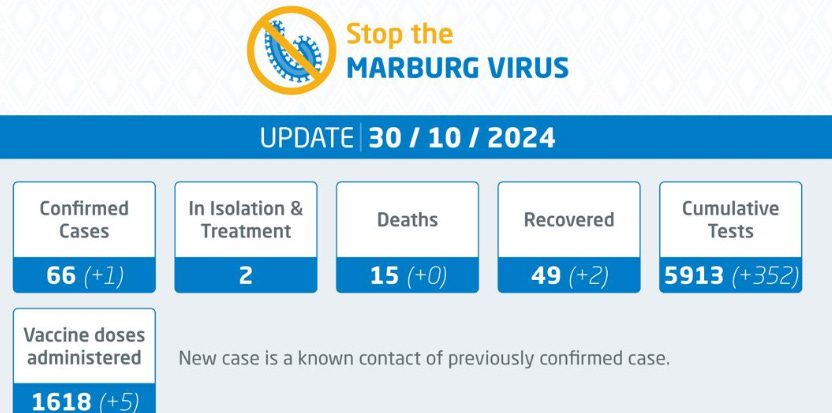UPDATE: The total MVD case count increased by one confirmed case today, October 30, bringing the total case count to 66. This came out a few hours after I posted this blog.
Original report:
As of October 29, a total of 65 Marburg virus disease (MVD) cases, including 15 deaths (case fatality ratio (CFR) 23.0%), have been reported in Rwanda.
Among the initial 62 confirmed cases with available data, 70% were males, and 48% were aged between 30 to 39 years.
Health workers from two health facilities in Kigali account for over 82% of confirmed cases. Most of the cases have been reported from the three districts in Kigali city.
Since the declaration of the outbreak by the Government of Rwanda on 27 September and as of 29 October, 47 confirmed cases have recovered, and three cases are under care at the designated Marburg treatment center.
As of 29 October 2024, a total of 5561 tests for Marburg virus have been conducted at the Rwanda Biomedical Center.
Based on available updates from the outbreak investigation, the index case was a male between 20 and 30 years old with a history of exposure to bats in a cave. Preliminary phylogenetic analyses indicate a close evolutionary relationship to a viral sequence from Orthomarburgvirus marburgense (Marburg virus, MARV) that was observed in the MVD outbreak in East Africa in 2014.
The current outbreak in Rwanda, the country’s first, is the third largest outbreak on record-
Uige Province, Angola, 2004-2005 - 252 cases and 227 deaths (90 percent fatality rate).
Durba, Democratic Republic of the Congo, 1998-2000 - 154 cases and 128 deaths (83 percent fatality rate).
According to the World Health Organization, MVD is a highly virulent disease that can cause hemorrhagic fever and is clinically similar to Ebola virus disease. Marburg and Ebola viruses are both members of the Filoviridae family (filovirus). People are infected with Marburg virus when they come into close contact with Rousettus bats, a type of fruit bat, that can carry the Marburg virus and are often found in mines or caves. Marburg virus then spreads between people via direct contact (through broken skin or mucous membranes) with the blood, secretions, organs or other bodily fluids of infected people, and with surfaces and materials (e.g. bedding, clothing) contaminated with these fluids. Health workers have previously been infected while treating patients with suspected or confirmed MVD. Burial ceremonies that involve direct contact with the body of the deceased can also contribute to the transmission of Marburg virus.
The incubation period varies from two to 21 days. Illness caused by Marburg virus begins abruptly, with high fever, severe headache and severe malaise. Severe watery diarrhoea, abdominal pain and cramping, nausea and vomiting can begin on the third day. Although not all cases present with haemorrhagic signs, severe haemorrhagic manifestations may appear between five and seven days from symptoms onset, and fatal cases usually have some form of bleeding, often from multiple areas. In fatal cases, death occurs most often between eight and nine days after symptom onset, usually preceded by severe blood loss and shock. There is currently no approved treatment or vaccine for MVD. Some candidate vaccines and therapeutics are currently under investigation.
Seventeen outbreaks of MVD have previously been reported globally. The most recent outbreaks were reported in Equatorial Guinea and the United Republic of Tanzania between February and June 2023. Additional countries that previously reported outbreaks of MVD in the African Region include Angola, the Democratic Republic of the Congo, Ghana, Guinea, Kenya, South Africa, and Uganda.






